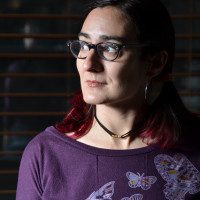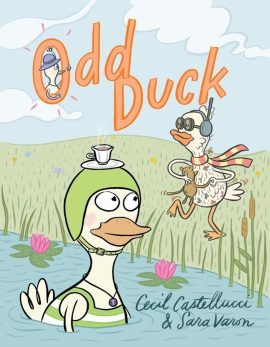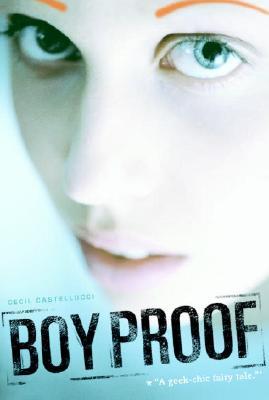Cecil Castellucci, perhaps the most wonderfully prolific and brazenly genre-busting author in Los Angeles, has worn many hats in a celebrated life in the arts—musician, stage performer, librettist, mentor to young writers, author, and editor, among them. With her latest title, Odd Duck, she proves once again that she can also write an engaging, entertaining, and wildly original book for young readers.
I managed to secure a few hours from Cecil’s busy schedule, forcing her to miss watching almost all of a playoff hockey game, to meet her for wine on a Tuesday in Los Feliz. Among many other things, we discussed her career, the habits that influence her remarkable creative output, her correspondence with fans, and what’s next in a writing life that has consistently defied easy categorization.
***
Rumpus: Let’s start with your newest book, Odd Duck. You had a charming and extremely well attended book release party at Skylight Books in Los Angeles for this one, in which the entire book was projected on a screen and read aloud. There was a room of small children eating out of your hand! Tell us about this book and what makes it so magical.
Cecil Castellucci: I like to think of Odd Duck as an early graphic novel chapter book for kids and the young at heart. It’s about an odd duck named Theodora who is a little bit troubled when another odd duck named Chad moves in next door. They both have a misunderstanding as to which one of them is actually the odd duck. It’s about friendship, understanding, and acceptance of another person, or duck, for who they are.
Rumpus: How did Odd Duck come together?
Castellucci: I sold it as a chapter book for very young readers. At first, the book was just going to have spot illustrations, but then my publisher hired Sara Varon, who happens to be one of my favorite comic book artists. I said, “Let’s throw out all of my words. This is a great opportunity to come up with something cool!” The initial publisher didn’t like what we came up with, so we left and eventually went to First Second, who totally got it. So this book took eight years to come out, and it was really hard-fought.
Rumpus: How has the reception been?
Castellucci: It’s been really nice. First Second says Odd Duck is for ages 6 and up, but I have friends with 3-year-old kids who love the book.because the 3-year-olds can follow the pictures as my friends read the story to them. For a kid just beginning to read, it’s a chapter book, so they can read it and feel satisfied about it. And then, some adults have been giving it to their adult friends, too. People have come up to me at signings and said, “This is actually for my best friend,” or “This is actually for my boyfriend.” I’m a big proponent of adults giving other adults picture books. Sometimes, Alexander and the Terrible, Horrible, No Good, Very Bad Day is the perfect gift for a friend who is just going through something challenging.
Rumpus: So you first conceived of Odd Duck around the time that your first novel, Boy Proof, came out in 2005.
Castellucci: That’s about right. 2006 was when I first conceived of it. It was supposed to come out in fall of 2008.
Rumpus: Many of your books, including Boy Proof and since, are categorized as Young Adult. As adults are not, nominally, the intended audience of YA books, what do you feel adult readers learn and experience from reading a YA book?
Castellucci: Well, I would say that a good book is a good book. I think it’s great that through the gateway of young adult fantasy/sci-fi books like Harry Potter or Hunger Games a lot of adults are reading YA. I think it’s because some of the best genre writing is going on in YA and that is hopefully happily leading people to reading great contemporary YA books.
At the end of the day, a book is a book is a book is a book, and a great book transcends marketing categories. YA is not a genre. It’s a marketing category that means it will have high interest for young adults. I think that we must remember that all of us lifelong readers fell in love with reading when we were young.
Most likely every reader has a middle grade book that they absolutely adored. YA is a fairly new category. Until relatively recently, readers would go from middle grade to adult books–mostly Sci-Fi fantasy, romance or mystery books—and then to high literature. I think that the fact that adults are discovering YA or what they can discover in going back to YA or middle grade (or even picture books, like Odd Duck!) is just going back to the basics of good storytelling. Just because these books have young main characters does not mean that books are not sophisticated. Many of them are high literature. It’s a shame when I hear an intelligent adult say, “Well I’m not a young person so it’s not for me.” You were a young person. And you like a good book. Then there is a great YA book out there for you.
Rumpus: Awesome. That’s a perfect answer. I’m also in awe of your output since 2005—ten books, a libretto to an opera, and countless short stories. What’s your writing schedule? How do you do this?
Castellucci: Time travel.
Rumpus: I knew it! I feel like Javert.
Castellucci: Actually, I give myself deadlines.
Rumpus: Well, that’s cool, too.
Castellucci: I also give myself a certain amount of time to work on projects. For example, right now I have to write book #2 of my science fiction series, so I know that I have six weeks, and it’s all I’m going to work on for those six weeks. I’m also working on an untitled hobo project that I’ll have to set aside for a little bit.
Rumpus: And by work, what does this mean every day? Do you have a usual schedule?
Castellucci: I feel that as an author, the page is always open, and you’re always working, whether you’re at your desk or not. Sometimes it doesn’t seem like doing the dishes is working on your novel, but part of your job is to dream and think and nourish your creative side. So it’s not like I write every day from 8 a.m. until 4 p.m. but I’m very strict about my deadlines. Sometimes this means that I don’t write anything for a week and then binge-write for three straight days. I get it done.
Rumpus: The book that started it all, publishing-wise, was Boy Proof, back in 2005. Was this your first completed manuscript? And if not, what was the process that led to this particular book being published?
Castellucci: I wrote three books before I wrote Boy Proof, so it was the fourth book that I wrote but the first one that I sold. The first I wrote was a YA novel called Chloe’s Jam. The second one was called Walking Away from Wonderland. I’m never going to do anything with those again. The third was Grandma’s Gloves.
Rumpus: Which eventually came out in 2010.
Castellucci: And what’s interesting about Chloe’s Jam is that it’s about a girl who plays classical violin, but discovers punk rock music, and joins a band.
Rumpus: That’s sort of the photonegative of Beige.
Castellucci: Beige is the better version of Chloe’s Jam. The heart of both of those books is exactly the same. Still, all of those unpublished books opened doors for me. I wouldn’t have gotten Boy Proof looked at seriously if Grandma’s Gloves hadn’t caught the eye of an editor. Even though it was depressing at the time not to sell those books, I feel like I gained cheerleaders along the way. I felt like my job wasn’t to worry about rejection, because it’s a 10-year waiting list to be an artist anyways. I felt like my job was just to get to work and write some more books. I just feel like you have to keep making work. I have stories I want to tell, and no one’s going to have my career for me.
Rumpus: One setting you write about often is high school. When you first started writing, did you set out specifically to write YA, or did you simply want to write stories set in high school, and discover YA later?
Castellucci: I always knew I wanted to write for young people. My answer is not going to be different from many other YA authors you speak to, but that’s when I fell in love with reading myself. One of the things that’s super-compelling about writing young adult fiction is that it’s the first time these characters are doing anything. First time they fall in love, first time they’re betrayed, first time they have a rage that makes them want to kill someone, and I think as a writer these moments are very fertile.
Rumpus: Did any one book in particular influence you as a young reader?
Castellucci: There was a book called A Wrinkle in Time, by Madeleine L’Engle, and what I really liked about it was that there was this girl, who had mousy brown hair and glasses. Her parents were scientists, which my parents are, and she had a brilliant younger brother, as I do. She saves the world, even though she seems mediocre and mousy. It was one of the first books I read where I really related to the character, and that’s a magical thing to find when you’re young.
A long time ago, someone suggested that I write Madeleine L’Engle a letter, and I said, “You know, I should.” I was twenty-five at the time and just went home, sat down, and wrote Madeleine L’Engle a letter. I said, “I loved your book” and then listed the reasons why I loved it so much. I wrote, “I think I’d like to write for young people one day.” I think it was the first time I wrote that down.
She wrote me a letter back. She said, “Dear Cecil, if you want to write for young people, why don’t you sit down and start writing for young people?” I realized I could just do that. I really have Madeleine L’Engle to thank for nudging me to do in my heart what I wanted to do.
Rumpus: That’s fantastic. And now that you write for young readers, what kinds of letters and feedback have you experienced?
Castellucci: For my graphic novel PLAIN Janes, I got this wonderful email from a girl who stole it from her library and never returned it. She loved the all-girl art gang in the book so much, she decided that she might want to be an artist. She wrote me from her second year of visual arts school in New York and said, “Thank you, so much—your book was the reason I became an artist.”
With Boy Proof, I got a letter once from a girl who said that she never got along with her mother, and her mother didn’t understand her at all, but one day she came downstairs, and her mother had bought her Boy Proof. She went upstairs and she read it. She said that it was the first gift from her mother that made her feel like her mom got who she was. Then they had their first-ever real conversation.
The Rumpus: That’s incredibly moving.
Castellucci: It was.
Rumpus: Besides your own work, what YA authors would you recommend for the uninitiated?
Castellucci: I’m going to say Elizabeth Knox. She has a great fantasy series called Dreamquake, it’s a duology—it’s what gave me the idea to do my own duology. I’m also a really big fan of Kathleen Duey’s Skin Hunger series. Her books can’t come out fast enough for me. Patrick Ness, his Chaos Walking trilogy is extraordinary. Markus Zusak, The Book Thief. M.T. Anderson, The Astonishing Life of Octavian Nothing. Melinda Lo, Ash, which is an amazing retelling of Cinderella. David Levithan’s Boy Meets Boy.
Rumpus: With your phenomenal output, I imagine you’re juggling projects right now. I’m curious as to what they are.
Castellucci: I’m working on A Stone in the Sky, which follows Tin Star as book two of my science fiction duology. I also have another book coming out next year, right now it’s untitled, but it might be called Over the Iron Rainbow. I’m not sure. It’s about a girl in 1932 who runs away from home, dresses up as a boy, meets an old hobo, and rides the rails during the Depression. It’s a graphic novel and it’s going to be illustrated by Joe Infurnari.
Rumpus: One theme that you seem to stress in your books is the idea of belonging, and your character’s definition within or outside of a group.
Castellucci: I would tweak that a little bit and say that I’m very interested in identity and finding your true tribe. It’s more about how you navigate this world and find your heart in it. I think that’s something we never stop looking for, even when we’re older, but those moments when you’re a teenager are when you’re really navigating those waters. Art is in all of my books as well—how art saves us, how art helps us find our heart.
Rumpus: Finally, as a YA author, do you feel like you’re ever writing books for your younger self?
Castellucci: I absolutely feel like I’m writing books for my younger self. I’m an outsider, I’m an odd duck, I’m a little bit of a weirdo. I write for the young women and young men who are outsiders as well, who are on the fringe. I think it’s extremely important that they can have books which help them discover, cherish, and celebrate their outsider status and let them know that they’ll be fine.






